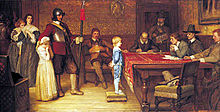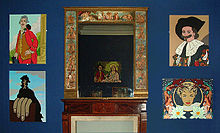Walker Art Gallery
The Walker Art Gallery is an art gallery in Liverpool that houses one of the largest art collections in England . Hence the Walker Art Gallery is often referred to as the National Gallery of the North . It contains paintings and sculptures by great masters and now almost unknown artists from the past 600 years.
history

Andrew Barclay Walker (1824-1893), a brewery owner and local politician, donated a gallery to the city of Liverpool in 1873 in memory of his tenure as mayor. Walker had not previously appeared as a patron or art collector, but was known for erecting public buildings of high architectural standard and making generous donations for charitable purposes. It is possible that Walker wanted to use this donation to raise the reputation of his brewery and the enjoyment of beer in general, after the alcohol consumption had fallen into disrepute by temperers during this time . Anyway, Walker donated £ 20,000 for the new gallery.
On September 28, 1874, Prince Alfred, Duke of Edinburgh laid the foundation stone of the Walker Art Gallery and the City Council approved £ 1200 for the purchase of additional works of art. On September 6, 1877, Edward Henry Stanley, 15th Earl of Derby , opened the Walker Art Gallery with great public sympathy. In the first four months, 324,117 visitors came to the exhibition rooms. In 1881 the number of visitors per calendar year reached a temporary high at 610,779, which corresponded to a daily average of over 2000 people.
In 1878 the gallery bought the painting And when did you last see your Father? For £ 750 . by William Frederick Yeames . Today it is one of the most famous and popular works in the gallery. In 1881 Dante's Dream at the Time of the Death of Beatrice could be purchased from Dante Gabriel Rossetti for £ 1,575. This and subsequent purchases of Pre-Raphaelite works , including Isabella from John Everett Millais in 1884 and Triumph of the Innocents from William Holman Hunt in 1891 , established the association with the Brotherhood. In 1882 the gallery came into the possession of the painting A Street in Brittany by Stanhope Forbes , which would be followed by other works of late Impressionist genre painting from the Newlyn School , including by Charles Napier Hemy , Ralph Todd and Edwin Harris .
In the following years, the gallery was expanded to include an annex, which was opened in 1884. Andrew Barclay Walker paid the entire cost of £ 11,500. In 1885 the collection already comprised over 360 works. In 1891 Il castigo delle lussuriose (Punishment of Lust) was bought from Giovanni Segantini for £ 315 . Segantini was one of the few modern foreign painters the gallery had acquired paintings from before 1900. In 1893 all loans from the Liverpool Royal Institution were given to the gallery indefinitely. The 15th Earl of Derby bequeathed £ 2,000 to the gallery in his will that year. The proceeds from this inheritance were used to purchase the works of up-and-coming young artists.
In 1908, the Walker Art Gallery hosted a Historical Exhibition of Liverpool Art . This comprehensive art show of the 18th and 19th centuries marked the beginning of serious investigation and targeted promotion of local artists. In 1910, the gallery acquired Horse Frightened by a Lion from George Stubbs for £ 22 . In 1917, John Elliot donated 44 paintings by mostly local artists. In 1923, James Smith bequeathed several important works to the gallery, including artists such as George Frederic Watts and Auguste Rodin .
In 1931, the Walker Art Gallery was closed to build another extension. The renovation was funded by donations from George Audley, FC Bowring and Thomas Bartlettin, who each contributed £ 10,000. George Audley, a beer and whiskey exporter, also donated 26 paintings to the gallery. In 1933, the Walker Art Gallery reopened with an exhibition that also featured paintings by Pablo Picasso and Paul Gauguin . Lord Wavertree, son of Andrew Barclay Walker, donated £ 20,000 that year and his entire collection of paintings. In 1934 the gallery exhibited works by Barbara Hepworth , Henry Moore and Paul Nash at the Unit One Show and purchased Snowdon from Llyn Nantlle from Richard Wilson for £ 950 the following year .
During the Second World War , the gallery was taken over by the Ministry of Health and Nutrition, which used the exhibition rooms for administration and sales. The collection was scattered around for security reasons. The repairs after the war took several years, so that the gallery could not be reopened until 1951. To mark the occasion, several important works were donated by local entrepreneurs, including Molly LongLegs by George Stubbs and a self-portrait by Rembrandt van Rijn . In the next few years, the Walker Art Gallery was one of the first galleries to carry out a regular conservation program for its works of art and had its own restoration studios on site.
In 1955 a Vincent van Gogh exhibition caused a sensation and long queues. In 1957 the first John Moores Painting Exhibition was held, donated by John Moores , the founder of the Littlewoods retail chain . Since then, this exhibition has taken place every two years together with an award-winning competition. The Walker Art Gallery began developing educational programs that included a wide range of activities for teenagers and adults. Soon the first full-time employee could be employed for further school education.
In 1960 the gallery acquired The Virgin and Child with St Elizabeth and the Child Baptist by Peter Paul Rubens for £ 25,000. In 1961, a fundraising appeal to local entrepreneurs raised over £ 70,000 in revenue, which was used to purchase the works of great masters, including Georges Seurat , Edgar Degas , Claude Monet and Paul Cézanne . In the 1960s, the Pre-Raphaelites were rediscovered and re-evaluated in terms of art history. In 1964, the first of three presentations was a Ford Madox Brown exhibition. In 1967 and 1969 exhibitions about John Everett Millais and William Holman Hunt followed . In 1967 David Hockney won the John Moores competition with Peter getting out of Nick's pool .
In the 1970s, long-term loans from the government were able to purchase three paintings from the Earl of Sefton's collection for the Walker Art Gallery, including Isabella, Viscountess Molyneux by Thomas Gainsborough . In 1979, the Walker Art Gallery organized an Allen-Jones - retrospective , the first in a series about British painter of modernity. In 1986 the gallery became part of the National Museums & Galleries on Merseyside . In 1995 the gallery acquired the Weld Blundell collection of old masters with drawings by Guido Reni and Andrea Mantegna . In 1997, more than 53,000 visitors flocked to an exhibition of works by the Victorian painter Lawrence Alma-Tadema .
In 1999, the Walker Art Gallery began major renovations as part of the Liverpool State Museums' Into the Future project . In 2002 the gallery was reopened. It now has a gallery for new prints and drawings, galleries for temporary exhibitions and extensively renovated galleries with works from the 17th century. The first exhibition in the new galleries was a major retrospective by the portraitist George Romney from the 18th century.
The Walker Art Gallery hosted The Stuckists Punk Victorian , the Stuckist Art Movement's first national museum exhibition in 2004 . The Stuckists are an international art movement that was founded in 1999 in London by Billy Childish and Charles Thomson as an alternative to the Young British Artists .
Famous artist
literature
- Edward Morris: The Walker Art Gallery, Liverpool. Scala Books, London 2007, ISBN 978-1-85759-037-1 .
- Mary Bennett: Walker Art Gallery Liverpool. Merseyside County Council, Liverpool 1978, ISBN 0-901534-60-9 .
Web links
Coordinates: 53 ° 24 ′ 36.2 " N , 2 ° 58 ′ 46.7" W.







